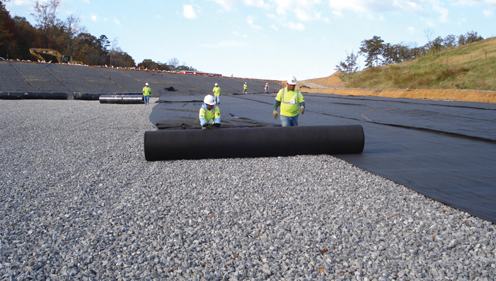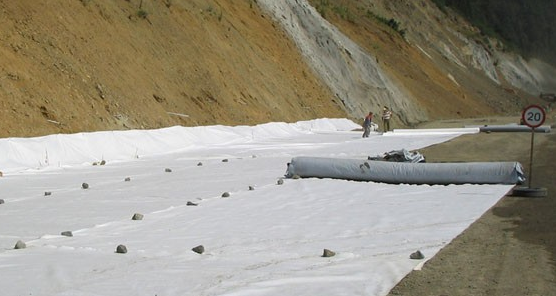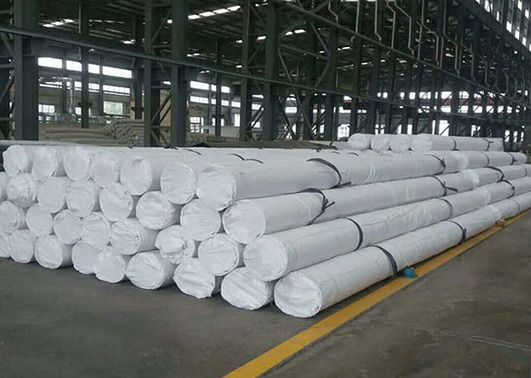Geotextiles are permeable fabrics which made from polypropylene or polyester, geotextile fabrics come in two basic forms: woven (resembling mail bag sacking) and nonwoven (resembling felt). Do you know what is non woven geotextile used for? This article we will share you something about non woven geotextile fabric uses.

The main function of nonwoven geotextile is drainage and filtration. Nonwoven geotextiles manufactured from either continuous filaments or staple fibres. Continuous filaments and staple fibres are used to separation, reinforcements, filtration, drainage, moisture barrier, etc for roads and railways off shore land reclamation, road side, rail side, river and canal banks and embarkments. Non-woven have some unique functions in geotextiles include filtration, drainage, separation, reinforcement, and erosion control, etc.

1. Filtration
Nonwovens materials are used to retain fine soil particles. This technique prevents fine particles from being leached and draining elements. It is probably the most common technique in geotextiles which invented in the mid-1960s.
2. Separation
Nonwovens are used to separate two layers of soil, which have different particle size distributions. It helps to prevent fine-grained subgrade soils from pumping up into permeable granular road bases. It prevents the two adjacent layers from mixing of a structure. Nonwoven separator is necessary to ensure the long-term performance of the structure. The applications in roads, railroads, walls, dams, embarkments, barriers, etc; in all of these, nonwovens are used in geotextile with separation as its primary function.
3. Drainage
Geotextiles are used as a passive element to transport liquids elements or gas elements. The drainage functions are done by the geotextile alone. But often it’s combined with other elements like: drainage core, perforated pipes, etc. Needle-punched geotextiles are used combined with other materials to increase drainage capacity. This combination is referred to as drainage geo-composites.
4. Reinforcement
Geotextile is used in reinforcement to increase the load-bearing capacity of soft soils. Reinforcement is a common application used in the field of road engineering. Nonwovens can reduce the level of stress in the foundation soil. Because, horizontal shear stresses are mobilized by vertical loads. This function of nonwoven spreads the load over a large area and decreases its intensity. The ultimate purpose is to be reduced the vertical stress and provide less possibilities from failure.
5. Liquid barrier
The open structure of nonwoven geotextiles allows itself to be soaked with combined with clay particles that enter open spaces within the structure of the geotextile to prohibit the passage of liquids.
6. Erosion control
Nonwoven fabrics acts both as a separator and as a drainage layer. But when its basic function is to aid in erosion control it is placed in special category. A much bigger possible market for nonwoven geotextiles exists in the soil erosion control.
According to the European standards, requirements of non woven geotextile fabric in the application areas are defined by: roads, railways, earthworks, retaining walls, drainage systems, erosion control, dams, canals, underground structures, solid waste disposal, liquid waste containment, etc.

The chart below can help you to find the various application area of nonwoven geotextiles:
(1)French Drains
(2)Filter Fabric
(3)Geo-membrane Cushion.
(4)Landscape Fabric
(5)Roadway Separation
(6)Roadway Stabilization
(7)Drainage
(8)Temporary Erosion Control
(9)Permanent Erosion Control
(10)Geomembrane Liner Protection
(11)Landfill Leachate Collection
(12)Landfill Drainage Systems
(13)Gas Venting
(14)Cow Carpet
(15)Drainage
(16)Pipe Wrap
(17)Railroad Ballast Separation
(18)Rip-Rap
(19)Separation Under Pavers
(20)Subsurface Drainage
(21)Trench Drains
(22)Underdrains
(23)Weed Barrier, etc
